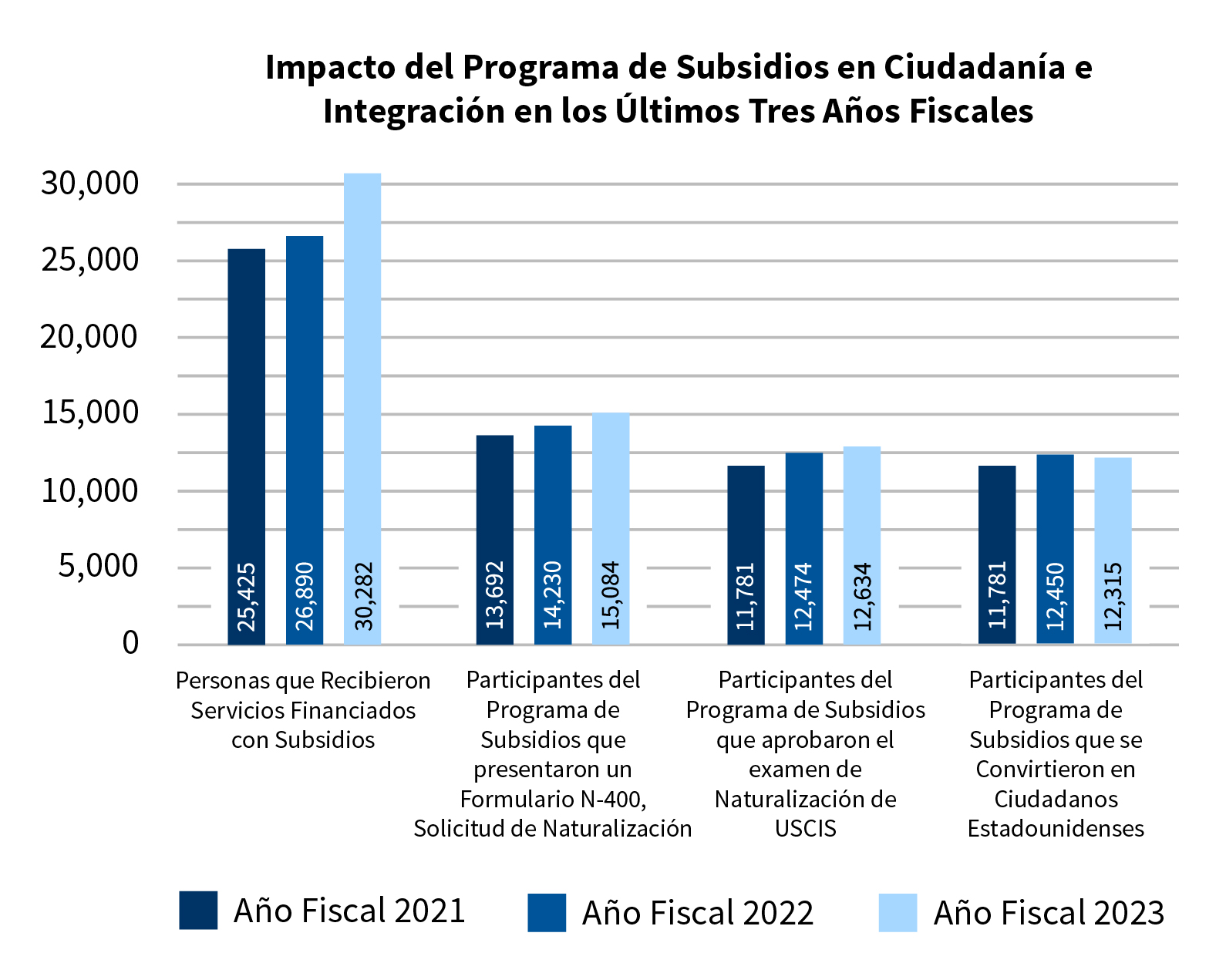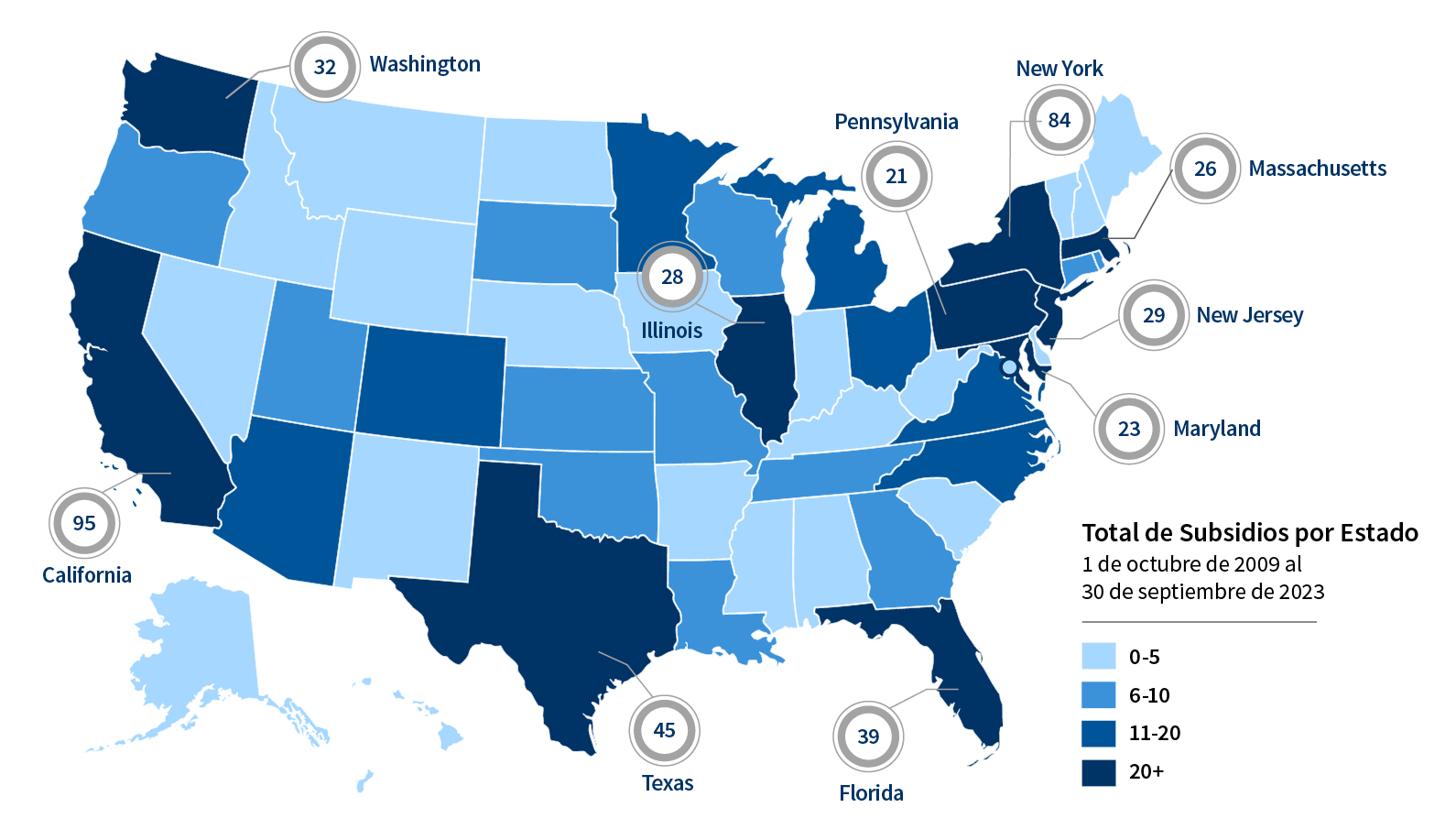Impacto del Programa de Subsidios

Descripción General del Programa de Subsidios de Ciudadanía e Integración (CIGP) de USCIS
Si bien muchos inmigrantes desean convertirse en ciudadanos estadounidenses, las barreras reales y percibidas para la naturalización a menudo impiden que las personas quieran naturalizarse. Cada año, aproximadamente el 10 por ciento de las personas elegibles para naturalizarse lo hacen, y esta tendencia ha persistido durante décadas. Como resultado, actualmente hay 9 millones de residentes permanentes legales (LPR) (PDF) elegibles para solicitar la ciudadanía de Estados Unidos.
El Programa de Subsidios de Ciudadanía e Integración de USCIS proporciona apoyo a organizaciones comunitarias sin fines de lucro e instituciones educativas que trabajan activamente para eliminar las barreras a la naturalización. El objetivo del Programa de Subsidios de Ciudadanía e Integración es ampliar la disponibilidad de servicios de alta calidad de preparación para obtener la ciudadanía para los LPR en todo el país y proporcionar oportunidades para que los inmigrantes adquieran los conocimientos y las habilidades necesarias para integrarse a la sociedad estadounidense. Los beneficiarios de los subsidios de USCIS proporcionan educación en el idioma inglés y educación cívica, asistencia legal con solicitudes de naturalización y crean un espacio comunitario para la integración de los inmigrantes. Entre los beneficiarios del Programa de Subsidios de Ciudadanía e Integración se encuentran varios tipos de organizaciones, como grupos comunitarios y religiosos, bibliotecas públicas y organizaciones de educación y alfabetización para adultos.
Todos los documentos esta disponibles en inglés
Desde que comenzó en 2009, el Programa de Subsidios de Ciudadanía e Integración ha otorgado más de $155 millones a través de 644 subsidios competitivos a organizaciones que proporcionan servicios a inmigrantes en 41 estados y el Distrito de Columbia. Ahora en su decimosexto año, el programa ha ayudado a más de 350,000 residentes permanentes legales a prepararse para la ciudadanía.
La siguiente tabla destaca el impacto específico del programa de subsidios en los últimos tres años fiscales


USCIS publica anualmente una Hoja Informativa del Programa de Subsidios de Ciudadanía e Integración que proporciona información adicional sobre las características y los resultados de los participantes del programa de subsidios. Tenga en cuenta que, las hojas informativas se publican mucho después del final de cada período de ejecución, para capturar los resultados precisos de todos los participantes del programa y permitir tiempos de procesamiento adecuados para los participantes que han presentado un Formulario N-400, Solicitud de Naturalización. Debajo de este acordeón se encuentra una lista de todas las hojas informativas disponibles actualmente.
USCIS mantiene una lista completa de todas las organizaciones que han recibido un subsidio del Programa de Subsidios de Ciudadanía e Integración. Navegue a los siguientes enlaces para obtener más información sobre el tipo de subsidios ofrecidos, qué organizaciones recibieron subsidios y las cantidades otorgadas a cada organización en cada año fiscal.
| Año Fiscal | Monto (en millones) | Número de Organizaciones Atendidas | Inicio del Período de Desempeño | Fin del Período de Desempeño |
|---|---|---|---|---|
| 2009 | $1.2 | 13 | 1 de octubre de 2009 | 30 de septiembre de 2010 |
| 2010 | $8.1 | 78 | 1 de octubre de 2010 | 30 de septiembre de 2012 |
| 2011 | $9 | 42 | 1 de octubre de 2011 | 30 de septiembre de 2013 |
| 2012 | $5 | 31 | 1 de octubre de 2012 | 30 de septiembre de 2014 |
| 2013 | $9.9 | 40 | 1 de octubre de 2013 | 30 de septiembre de 2015 |
| 2014 | $10 | 40 | 1 de octubre de 2014 | 30 de septiembre de 2016 |
| 2015 | $10 | 40 | 1 de octubre de 2015 | 30 de septiembre de 2017 |
| 2016 | $10 | 46 | 1 de octubre de 2016 | 30 de septiembre de 2018 |
| 2017 | $10 | 45 | 1 de octubre de 2017 | 30 de septiembre de 2019 |
| 2018 | $10 | 40 | 1 de octubre de 2018 | 30 de septiembre de 2020 |
| 2019 | $10 | 41 | 1 de octubre de 2019 | 30 de septiembre de 2021 |
| 2020 | $10 | 39 | 1 de octubre de 2020 | 30 de septiembre de 2022 |
| 2021 | $10 | 40 | 1 de octubre de 2021 | 30 de septiembre de 2023 |
| 2022 | $20 | 66 | 1 de octubre de 2022 | 30 de septiembre de 2024 |
| 2023 | $22 | 65 | 1 de octubre de 2023 | 30 de septiembre de 2025 |
Durante los últimos 16 años, USCIS ha ofrecido una variedad de oportunidades de fondos, cada una con diferentes requisitos y objetivos del programa. La sección a continuación proporciona una descripción general de los tipos de subsidios que USCIS ha proporcionado en los últimos tres años fiscales, información sobre los objetivos de cada oportunidad de fondos y cómo USCIS ha medido el desempeño. En el marco de todos los subsidios de Programa de Subsidios de Ciudadanía e Integración, los receptores de los subsidios informan todas las mediciones de desempeño trimestralmente durante la duración del período de desempeño.
Subsidios para Servicios de Educación en Ciudadanía y Servicios Relacionados con la Solicitud de Naturalización (CINAS)

USCIS mide el desempeño de los beneficiarios de los Subsidios para Servicios de Educación en Ciudadanía y Servicios Relacionados con la Solicitud de Naturalización utilizando las siguientes mediciones:
1. Número de residentes permanentes legales recién inscritos (no duplicados) que se inscriben en clases de instrucción de ciudadanía;
2. Porcentaje de estudiantes inscritos que toman un examen posterior utilizando un examen estandarizado a nivel nacional;
3. Porcentaje de estudiantes que realizan el examen posterior y que demuestran avances educativos cuantificables (medidos en un punto porcentual entre el examen anterior y el posterior);
4. Número de residentes permanentes legales para quienes la organización proporcionará evaluaciones de elegibilidad para la naturalización;
5. Número de residentes permanentes legales para quienes la organización preparará y presentará el Formulario N-400 y el Formulario G-28.
Subsidios de la Red de Integración Comunitaria y Regional (CARING)

La oportunidad de fondos de Subsidios de la Red de Integración Comunitaria y Regional apoya a las organizaciones que proporcionan servicios de integración cívica ampliados a poblaciones inmigrantes vulnerables específicas, como refugiados y asilados. Al igual que el subsidio CINAS, los receptores de Subsidios de la Red de Integración Comunitaria y Regional ofrecen clases de ciudadanía y servicios de solicitud de naturalización. Sin embargo, a diferencia del subsidio CINAS, los participantes del programa Subsidios de la Red de Integración Comunitaria y Regional pueden cualificar para los servicios con un nivel más bajo de conocimientos del idioma inglés, en reconocimiento del hecho de que muchos refugiados y asilados no han tenido acceso a las mismas oportunidades educativas que otros inmigrantes debido a sus experiencias de desplazamiento. Además, las organizaciones que reciben subsidios desarrollan planes de integración individualizados para cada inmigrante que participa en el programa. USCIS mide el desempeño de los receptores de Subsidios de la Red de Integración Comunitaria y Regional utilizando los siguientes criterios:
- Número de planes de integración desarrollados;
- Número de inmigrantes recién inscritos (no duplicados) que se inscriben en clases de instrucción sobre ciudadanía;
- Porcentaje de estudiantes inscritos que realizan exámenes posteriores;
- Porcentaje de estudiantes que realizan exámenes posteriores que demuestran avances educativos cuantificables;
- Número de inmigrantes para quienes la organización proporcionará evaluaciones de elegibilidad para la naturalización;
- Número de inmigrantes para quienes la organización preparará y presentará el Formulario N-400 y el Formulario G-28.
Subsidio para Núcleos Regionales

En el año fiscal 2022, USCIS otorgó tres subsidios para núcleos regionales de hasta $1 millón cada uno. USCIS ofreció este subsidio nuevamente en el año fiscal 2023, pero no otorgó ninguno para núcleos regionales ese año. El receptor principal también es responsable de servir como centro de comunicación e intercambio de información sobre la preparación para la obtención de la ciudadanía dentro de la comunidad en general. USCIS mide el desempeño de los receptores de los subsidios para centros regionales a través de las siguientes mediciones:
- Número de reuniones regulares con los grupos de interés realizadas por el solicitante principal;
- Número de personas que asisten a cada reunión con los grupos de interés;
- Número de inmigrantes recién inscritos (no duplicados) en clases de educación en ciudadanía (total y por subsolicitante);
- Porcentaje de estudiantes inscritos que realizan exámenes posteriores utilizando exámenes estandarizados a nivel nacional de dominio del idioma inglés (total y por subsolicitante);
- Porcentaje de estudiantes que se sometieron a exámenes posteriores y que demuestran avances educativos cuantificables (total y por subsolicitante);
- Número de inmigrantes para los cuales cada subsolicitante realiza evaluaciones de elegibilidad para la naturalización;
- Número de inmigrantes para los cuales cada subsolicitante prepara y presenta los Formularios N-400 y G-28.
Subsidios para la Innovación en la Preparación para la Obtención de la Ciudadanía

Este anuncio de oportunidad de fondos fue diseñado para apoyar y ampliar los enfoques innovadores para preparar a los inmigrantes para la naturalización y alentar la integración cívica, lingüística, económica y cultural de los inmigrantes en sus comunidades. Mientras que otras oportunidades de financiamiento de USCIS apoyan servicios específicos de preparación para la ciudadanía, el programa de innovaciones invierte en iniciativas que desarrollan, prueban y comparten soluciones creativas para superar las barreras a la naturalización y ampliar el acceso a la educación y los servicios de preparación para la ciudadanía. A través de esta oportunidad de financiamiento, las organizaciones desarrollan, prueban y comparten soluciones creativas para superar las barreras tradicionales a la naturalización. Cuando USCIS ofreció por primera vez los subsidios de innovaciones en el año fiscal 2022, el subsidio se llamó Innovaciones en Educación para la Ciudadanía y se pidió a los beneficiarios que seleccionaran dos o más medidas de desempeño de la siguiente lista:
- Número de estudiantes que se inscriben en una clase de educación para la ciudadanía como resultado de la innovación;
- Porcentaje de estudiantes que demuestran ganancias de aprendizaje cuantificables como resultado de la innovación propuesta;
- Número de estudiantes o participantes que presentan el Formulario N-400, Solicitud de Naturalización, como resultado de la innovación propuesta;
- Número de nuevas asociaciones comunitarias creadas, como lo demuestra un Memorando de Entendimiento, para apoyar la preparación para la ciudadanía y/o la integración de inmigrantes en la comunidad;
- Número de inmigrantes “difíciles de alcanzar” involucrados a través de una campaña de divulgación dirigida sobre la ciudadanía;
- Número de inmigrantes que reciben capacitación sobre (o utilizan) una nueva herramienta de educación para la ciudadanía.
En el año fiscal 2023, USCIS cambió el nombre al subsidio para la Innovación en la Preparación para la Obtención de la Ciudadanía, actualizó el diseño del programa para reflejar las lecciones aprendidas durante el primer año y comenzó a medir el desempeño a través de las siguientes mediciones:
- ¿El beneficiario presentó un plan de proyecto revisado a más tardar el 30 de diciembre de 2023? (sí/no)
- ¿El beneficiario completó el desarrollo de su innovación según las especificaciones de su propuesta y plan de proyecto a más tardar el 30 de diciembre de 2024? (sí/no)
- ¿El beneficiario probó y perfeccionó su innovación según fuera necesario y luego la compartió públicamente de acuerdo con el plan del proyecto? (sí/no)
